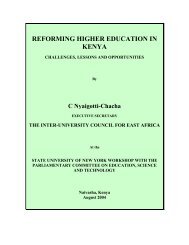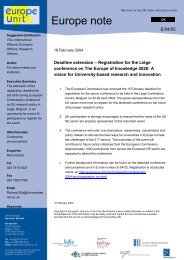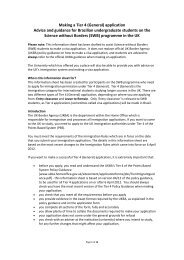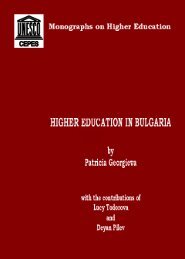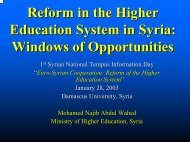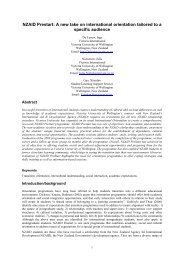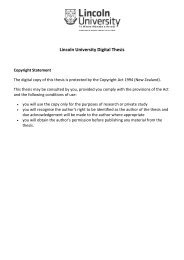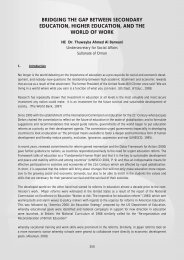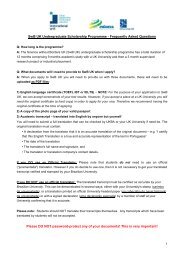POSITIONING TO MEET GLOBAL COMPETITION: THE HIGHER ...
POSITIONING TO MEET GLOBAL COMPETITION: THE HIGHER ...
POSITIONING TO MEET GLOBAL COMPETITION: THE HIGHER ...
Create successful ePaper yourself
Turn your PDF publications into a flip-book with our unique Google optimized e-Paper software.
International forum: “Globalization and Integration in higher education”<br />
<strong>POSITIONING</strong> <strong>TO</strong> <strong>MEET</strong> <strong>GLOBAL</strong> <strong>COMPETITION</strong>:<br />
<strong>THE</strong> <strong>HIGHER</strong> EDUCATION CHALLENGE<br />
Darlyn Damasco-Tagarino<br />
Vice-President for Planning, Development, and Business Affairs<br />
Benguet State University, the Philippines 1<br />
ABSTRACT<br />
Globalization is a growing challenge to higher education institutions worldwide. It refers to the<br />
phenomenon where the borders separating countries are disappearing. Globalization is very<br />
closely intertwined with internationalization. Its rationales and key determinants are varied.<br />
However, globalization brings with it not only opportunities but also threats. In the Philippines,<br />
there is a dearth of literature on the effects of globalization to higher education.<br />
This paper proposes that higher education institutions should consider positioning as a strategy<br />
to ride the tide of globalization. Positioning means establishing a perceptual location or staking a<br />
place in the global consumer’s mind to ensure the best advantage. Four ways are suggested to<br />
position higher education institutions to meet global competition. First, know the current position.<br />
This can be done by analyzing the current level of internationalization effort, identifying the<br />
current programs and clients, and pinpointing available resources. Second, identify the desired<br />
position. The institution’s vision and mission is the starting point. One possible positioning for<br />
developing countries is to adopt a market niche. Third, determine value and leverage. Value<br />
corresponds to one’s strengths and the promising opportunities that one can leverage on. Fourth,<br />
create the buy-in which means creating the conditions to make one’s desired position possible.<br />
The suggested ways include: offer an attractive service mix, empower human resources, upgrade<br />
infrastructure, and create as well as seek synergy. Finally, stick it out. Before one embarks on an<br />
actual positioning stance, one has to assess if it can be sustained in the long run. Sustainability<br />
will be determined by the extent of institutionalization and mainstreaming, the presence of an<br />
enabling macro-environment, and the development of quality assurance and protocols.<br />
1 INTRODUCTION<br />
Globalization is a theme that holds a lot of people captive. It refers to the phenomenon<br />
where the borders separating countries are disappearing. This allows “the flow of<br />
technology, economy, knowledge, people, values, and ideas … across borders.<br />
Globalization affects each country in different ways due to each nation’s individual<br />
history, traditions, cultures, resources and priorities. Globalization increases and reflects<br />
greater interdependency and interconnectedness in the world” (Knight and De Wit, 1997).<br />
This paper dwells on the challenges and opportunities that globalization poses to higher<br />
education institutions. The emphasis is on the Philippine setting with the hope that in the<br />
course of the paper, some nuggets of wisdom may be obtained by higher education<br />
institutions for future application.<br />
The paper is divided into three major parts. The first discusses the concept of<br />
globalization and the motivations for internationalization by higher education institutions.<br />
The second highlights higher education in the Philippines and some views on the effects<br />
of globalization. The third section suggests some strategies to position higher education<br />
institutions to meet global competition with the Philippines as a case in point.<br />
1 Prof. Dr. D. Tagarino is Vice President for Planning, Development and Business Affairs and the Director<br />
of the International Relations Office at the Benguet State University, Philippines.
International forum: “Globalization and Integration in higher education”<br />
2 <strong>GLOBAL</strong>IZATION & INTERNATIONALIZATION<br />
Globalization and internationalization are intertwined. As countries open up to external<br />
forces, the same countries have to be ready for the ushering of new technologies and<br />
influences. Specifically, Knight and De Wit (1997) gave the working definition that<br />
“internationalization of higher education is the process of integrating an<br />
international/intercultural dimension into the teaching, research, and service functions of<br />
the institution.” Internationalization pertains to the readiness to embrace globalization,<br />
prompting higher education institutions to take a proactive stand towards mainstreaming<br />
in the global arena. In the field of higher education, globalization has brought such<br />
concepts as “borderless,” “transnational,” “transborder,” and “crossborder” education.<br />
Regardless of the term, the implication is for higher education institutions to view this<br />
phenomenon as an opportunity, and to take the appropriate stand to grab the advantages it<br />
may bring. Corollary, it challenges higher education institutions to be on guard so as not<br />
to fall victim to the fierce competition it may bring.<br />
The rationales behind globalization are diverse (De Wit, 1999). In fact, Knight (1997)<br />
clustered the rationales for internationalization into four groups, namely: 1) political,<br />
where it ensures a country’s position and role as a nation in the world contributing to<br />
security, stability, and peace; and assuring ideological influence, among others; 2)<br />
economic, where it contributes to the skilled human resources needed for international<br />
competitiveness of the nation, and where foreign graduates are seen as keys to the<br />
country’s trade relations; or direct economic benefits e.g. institutional income and net<br />
economic effect of foreign students; 3) academic, where it leads to the achievement of<br />
international standards for quality teaching and research, and is a major positive change<br />
agent for institution building; and 4) cultural and social, which concentrates on the role<br />
and place of the country’s own culture and language, and on the importance of<br />
understanding foreign languages and culture.<br />
Four key elements of globalization are described in the 2004 UNESCO education position<br />
paper as follows: 1) the growing importance of the knowledge society/economy; 2) the<br />
development of new trade agreements which cover trade in education services; 3) the<br />
innovations related to ICT; and 4) the emphasis on the role of the market and the market<br />
economy. These factors are catalysts to new developments, namely: a) the emergence of<br />
new education providers such as multi-national companies, corporate universities, and<br />
media companies; b) new forms of delivering education including distance, virtual, and new<br />
face-to-face; c) greater diversification of qualifications and certificates; d) increasing<br />
mobility of students, program, providers, and projects across national borders; e) more<br />
emphasis on lifelong learning which in turn increases demand for post-secondary education;<br />
and f) increasing amount of private investment in the provision of higher education.<br />
The International Association of Universities (IAU) own-member’s survey in 2003 on the<br />
Internationalization of Higher Education Practices and Priorities, unravels seven benefits<br />
of internationalization (Knight, 2003). These are student, staff, and teacher development;<br />
teaching and learning; research; competitiveness; networks; cultural awareness; and<br />
standard and quality. There are different levels of prioritization by universities grouped<br />
according to region. For instance, Asian and North American universities ranked student,<br />
staff, and teacher development as the foremost benefit of internationalization. This is in<br />
stark contrast with European universities which identified the setting of standards and<br />
quality as foremost. In terms of risks, the following were identified: brain drain, erosion<br />
of cultural identity, increased costs, and imposition of programs in the English language.
International forum: “Globalization and Integration in higher education”<br />
Asian and North American universities are most concerned with the risk of increased cost<br />
while African, Middle Eastern, and European universities feared brain drain. Latin<br />
American universities, on the other hand, were most concerned with the possible loss of<br />
cultural identity.<br />
3 PHILIPPINE <strong>HIGHER</strong> EDUCATION AND <strong>GLOBAL</strong>IZATION<br />
In the Philippines, higher education institutions total 1,647 (CHED, 2006) of which<br />
private colleges and universities comprise 89%. State colleges and universities,<br />
city/provincial, and other government schools represent the remaining 11%. Higher<br />
education has always been led by the private sector. Private higher institutions are<br />
established under the Corporation Code of the Philippines and are governed by special<br />
laws and general provisions of this Code. There are basically two categories: the nonsectarian<br />
and the sectarian ones, which are owned and run by religious organizations.<br />
Generally, Philippine private higher education institutions are covered by the policies,<br />
standards, and guidelines of the Commission on Higher Education (CHED). This covers<br />
program offerings, curriculum, administration and faculty academic qualifications, among<br />
others. A total of 79 private higher education institutions have autonomy or deregulated<br />
status in recognition of their quality education, research, and extension work.<br />
Public higher education institutions, on the other hand, are largely state colleges and<br />
universities, which are established by law, administered and financially subsidized by the<br />
government. The state universities have their own charters and have a Board of Regents<br />
(Board of Trustees for state colleges) that formulates and approves policies. The Board is<br />
headed by the Chairman of the CHED or by one of the four commissioners. There are<br />
also a few universities and colleges established and financially supported by the local<br />
governments through resolutions or ordinances, as well as a handful of CHED supervised<br />
institutions considered as non-chartered public post-secondary education institutions.<br />
Higher education programs are also offered by public secondary and post-secondary<br />
education institutions with usually a technical-vocational nature. Finally, there are special<br />
higher education institutions directly under a government agency as stipulated in the law<br />
that created them to provide specialized training in areas such as military science and<br />
national defense.<br />
The impact of globalization in the Philippines is perceived to be good by a majority of the<br />
Filipinos. According to the AC Nielsen (2006) online survey conducted in November<br />
2005 among 23,500 regular Internet users in 42 markets in Europe, North America, Asia-<br />
Pacific, Latin America, South Africa, and the Middle East, consumers in the Philippines,<br />
Malaysia, Taiwan, South Africa, and India unanimously agree on the value of<br />
globalization. It is notable that 73% of the Filipinos surveyed agree that globalization has<br />
brought increased job and career opportunities. While the reference was not specific to<br />
higher education, the survey has important implications for the sector. Globalization<br />
requires that the demand for Philippine labor should be matched by a supply of graduates<br />
with relevant courses.<br />
In developing countries, however, there is very limited factual information about the<br />
impact of globalization on higher education. In the Philippines, there are scattered cases<br />
of universities entering into various modes such as: 1) the development of e-courses; 2)<br />
international apprenticeship programs like in the fields of nursing, hotel and restaurant<br />
management, agriculture, and IT; 3) sisterhood agreements; 4) faculty/student exchanges;
International forum: “Globalization and Integration in higher education”<br />
5) research collaborations; and 6) cultural exchanges. However, further research on this<br />
matter is desired. There is dearth of knowledge in terms of a consolidated picture of the<br />
globalization efforts as well as an assessment of the level of effectiveness and efficiency<br />
of the current initiatives. Altbach (2002) rightly observes that the voices discussing<br />
globalization and internationalization are largely western except for a perspective view<br />
from India.<br />
4 <strong>POSITIONING</strong> IN <strong>THE</strong> <strong>GLOBAL</strong> <strong>HIGHER</strong> EDUCATION MARKET<br />
Positioning is a marketing term used as a “relative competitive comparison.” It was<br />
popularized by Al Ries and Jack Trout in the eighties. In this paper, it is proposed that<br />
higher education institutions consider positioning as a strategy to ride the tide of<br />
globalization. While the application seems suited only to private education institutions, it<br />
does not necessarily preclude public institutions.<br />
Positioning is being deliberate in how one wants to be defined by the target market in<br />
relation to competition. It is taking the move to be in the best place possible for one’s own<br />
advantage. It is establishing a perceptual location, staking a place in the global market,<br />
and willing others to accept it. Such a perceptual location may be based on a single<br />
attribute like institutional skills, or a combination of attributes as program mix and skills.<br />
How can universities position themselves to gain an edge in the face of globalization<br />
How can higher education institutions handle the competition spawned by globalization<br />
The subsequent section discusses how this can be done with specific reference to the<br />
Philippines, and borrowing from a mix of strategic management concepts.<br />
First, know the current position. For this situation, it is necessary to analyze one’s<br />
current level of internationalization effort, identify the current programs and clients, and<br />
pinpoint available resources. A useful tool for this process of assessing one’s prevailing<br />
position is perceptual mapping.<br />
In the IAU survey, Knight (2003) found that there are five most important aspects of<br />
internationalization by higher education institutions. These are student mobility, research<br />
cultural identity, faculty mobility, curriculum, and development projects. The findings for<br />
Asian universities indicated that 50% consider student mobility as an important aspect of<br />
internationalization. Upon deeper investigation, it was qualified that Asian universities are<br />
more interested in welcoming/recruiting students than sending students abroad or<br />
establishing exchanges. This is one indication of the positioning that may be taken by<br />
some universities in the region.<br />
For developing countries like the Philippines, the reality of low gross domestic product;<br />
inadequate funding for education; and the dominance, dependence, and vulnerability in<br />
international relations (Todaro, 2001) put a limit on the aspects of internationalization efforts.<br />
In most cases, there is a financial constraint in sending students abroad using own-funds. In<br />
exchange agreements, there is a skew for western partners whose students can afford to<br />
defray money for such programs. The observation made by Altbach (2002) that the flow of<br />
students overseas move largely from developing countries to the industrialized nations is true<br />
largely for able countries like Japan, Thailand, Korea, and China, to name some.<br />
Identifying the current programs and clients can assist in situating one’s position in the<br />
global market. In Asia, the IAU survey (Knight, 2003) further identified social science,<br />
business administration, and arts and humanities as the most “internationalized”<br />
disciplines. With a good knowledge of the demand, one can know who the major clients
International forum: “Globalization and Integration in higher education”<br />
are and from where they are coming. An assessment of the available resources will<br />
explain further one’s current position. To understand essential abilities and potentials, it is<br />
necessary to audit current resources (staff, skills, budget, technology, equipment),<br />
management infrastructure (strategies, policies, structure, systems, and processes), and<br />
leadership visions and values.<br />
Most marketing experts suggest the use of a perceptual map in identifying current<br />
position. A perceptual map helps situate an institution using criteria relevant in meeting<br />
competition. Although this paper does not elaborate on perceptual maps, it mentions it is<br />
an alternate tool.<br />
Second, identify the desired position. The best starting point in staking a position<br />
originates from one’s vision and mission. The vision from the words of one author is the<br />
magnetic north. This is what one aspires to become as a higher education institution. The<br />
mission is what makes for uniqueness. The vision and mission are the embodiment of<br />
stakeholders’ aspiration. Without them, an institution will strike whichever way in the<br />
face of globalization. This can mean a waste of vital resources, and high frustration for<br />
not getting to where one really wants to be.<br />
The perception of one’s place and role in the global higher education landscape is<br />
determined by the reputation one wants to establish in the future. It is practically rooted<br />
from what is current, but goes beyond with a hope for what may be feasible. American<br />
universities, though now severely challenged, are still perceived as being in the top rung<br />
of the higher education ladder. Australian universities currently have the perception of<br />
being strong contenders with their blend of relevant programs and high quality research.<br />
European universities are evidently regrouping to capture a better place in the global<br />
market. The aspiration of higher education institutions in developing countries, in this<br />
regard, is not evident.<br />
One practical position that seems compelling to developing countries, given obtaining<br />
conditions, is a market niche. This is equivalent to identifying the small pond upon which<br />
one can be the big frog. A niche is defined as a more narrowly defined group seeking a<br />
distinctive mix of benefits (Kotler, 2003). An attractive niche is characterized as having<br />
customers with a distinct set of needs, willingness of the customers to pay for a premium,<br />
the unlikelihood of the niche attracting other competitors, economies obtained through<br />
specialization, and the niche has size, profit, and growth potential.<br />
Establishing a niche means defining the market in which one intends to compete<br />
effectively. There are already established players in the global higher education ballgame.<br />
It is nonsensical for developing countries to lay a stake on that which the big leaguers<br />
already dominate. Effectively positioning higher education institutions in the developing<br />
countries means taking a pragmatic view of one’s own territory. It is realistically targeting<br />
a space that is possible within the rules of the game and within one’s own set of<br />
capabilities. Niching is recognizing one’s current position and not being overly ambitious.<br />
The current position is the hinge upon which future position can swivel. Kotler (2003)<br />
suggests that multiple niching i.e., specializing on a number of attributes in the higher<br />
education market, can have a higher chance of longer-term survival than single niching.<br />
Third, determine value and leverage. Value corresponds to one’s strengths and the<br />
promising opportunities that one can leverage on. It is essential to know exactly what<br />
one’s strengths are. It may be any of the following: normative- something one is doing<br />
that is theoretically correct; historical- something that over time one has exhibited a
International forum: “Globalization and Integration in higher education”<br />
competence for; competition- something that one can do much better than others; and<br />
critical areas- meeting or exceeding known critical success factors in the higher education<br />
practice. Ritzen (2006) identifies the positive comparative advantage of US and<br />
Australian universities to be language climate and quality. European universities have the<br />
edge on climate quality while language is the negative advantage. The Philippines, among<br />
Southeast Asian countries, occupies a notable position in the following education areas:<br />
maritime, health (nursing and care giving), information and communications technology<br />
(backoffice operations, animation), and English. A pitch for ICT investments highlights<br />
the Philippine competitive edge evident from an English speaking, highly educated, easily<br />
trainable, and skilled workforce. A basic policy environment that is right for business,<br />
government commitment at the highest level, a strong private support, and a rising<br />
entrepreneurial abilities suitable for a globalizing economy are all areas of strength<br />
currently being explored to leverage in the international market.<br />
To leverage is to adopt steps that are strategic to the country. It involves identifying both<br />
what should be done considering available resources and capabilities and what should not<br />
be done. In the case of the Philippines, there is the encouraging move to streamline higher<br />
education to make it efficient and effective. The Commission on Higher Education seeks<br />
to optimize the returns from the utilization of higher education resources by rationalizing<br />
program offerings and resource allocation, and by improving the available labor-market<br />
information. This should be done as well at the level of the individual higher education<br />
institutions.<br />
Likewise, to leverage implies the adoption of bite-size activities that address do-able and<br />
important concerns. One immediate practical consideration for the Philippines is to begin<br />
with changing the school calendar and to jibe it with most countries where the academic<br />
year starts in September instead of June. This consideration will make it easy to<br />
complement activities like exchange programs and scholarships. Another area is to consider<br />
adding to the number of schooling years in order to graduate more mature students.<br />
Filipinos are expected to complete their four-year bachelor degrees at 20 years of age.<br />
Fourth, create the buy-in. Establishing a position entails creating the conditions to make<br />
this possible. This is termed as buy-in. The following four elements for creating an<br />
effective buy-in are proposed:<br />
Offering an attractive service mix. Qiang (2003) gives a good conceptual framework that<br />
can be a guide in developing an attractive service mix. The major elements include<br />
academic programs, research and scholarly collaborations, extra-curricular activities, and<br />
external relations (domestic and offshore). Along academic programs, a range of<br />
possibilities are available from an internationalized curricula, joint and double degree<br />
programs, cross-cultural training, faculty/staff/student mobility, visiting lecturers and<br />
scholars, area or thematic studies, to foreign language study.<br />
The regular programs should be reviewed according to content and relevance. In the<br />
Philippines, programs are too heavy on general education courses sometimes at the<br />
expense of the specialization courses. An internationalized curriculum will certainly yield<br />
adjustments that may change program content, or even program range where new and<br />
relevant fields may be introduced. Van Ginkel (2002) suggests three ways to open up<br />
programs, namely: make them multi-disciplinary, widen the scope, and adopt diverse<br />
approaches. A good suggestion is for universities to now integrate in their curriculum<br />
other cultural spheres for a varied interpretation of the world.
International forum: “Globalization and Integration in higher education”<br />
Special programs may also be offered based on specific needs of particular clients. For<br />
instance, the offering of functional English courses by universities in the Philippines is a<br />
strong response to the demand brought about by the increasing influx of non-English<br />
speaking nationals from neighboring countries.<br />
Qiang (2003) further elaborates that research and scholarly collaboration can be tackled<br />
through joint research projects, international conferences and seminars, publications,<br />
international research agreements, graduate/research exchange programs, international<br />
research partnerships, to name some. It should be noted that scientific collaboration in<br />
trailblazing science through pure research or expanding applications by way of applied<br />
research becomes marked in a globalized setting. A research agenda with a broadened<br />
scope then becomes imperative. Corollary, research should be well integrated into teaching.<br />
The formation of student clubs and associations, international and intercultural campus<br />
events, liaison with community-based cultural groups, peer groups and programs, alumni<br />
development programs, and social, cultural, and academic support systems, can comprise<br />
the mix on extra-curricular activities.<br />
Moreover, external relations in the form of community, private sector or NGO-based<br />
partnerships, international development assistance projects, offshore teaching sites and<br />
distance education, customized/contract training programs, and community service and<br />
intercultural project work, may also comprise the service mix.<br />
An appropriate mix will not be complete without stipulating the price and accompanying<br />
promotion schemes. The developing countries have the advantage of offering new programs<br />
to international students at cheaper rates relative to the industrialized nations. As such, a<br />
good package where the service features of programs that will be offered, a competitive<br />
price, and how it can be made easily known to target clients, should be prepared.<br />
Empower human resources. A curricular program is only as good as its content and the<br />
mode of delivery. Both are a function of abilities and expertise of the university’s human<br />
resources. To encourage buy-in, capability building is a must. There are many avenues of<br />
capability building in the context of internationalization. Some schemes were already<br />
mentioned. Provision of the various typologies of the service mix as mentioned in the<br />
preceding section gives the various ways of HRD empowerment. The target is to create a<br />
critical mass of faculty members and staff that can lead the process of internationalization<br />
and turn this to the advantage of the university.<br />
Upgrade infrastructure. In today’s higher education landscape, the best way to invest in<br />
infrastructure is to invest in ICT. Information and communications technology is<br />
recognized as the driving factor in the process of globalization. (AC Nielsen, 2006).<br />
Deliberate sacrifices will have to be made for investments to be placed in connecting the<br />
universities to the information highway. For developing countries, this may represent<br />
some huge opportunity costs. But it is cost that must be paid. Needless to say, investments<br />
on teaching resources such as books, equipment, and other facilities are similarly vital.<br />
Create and seek synergy. Collaboration and cooperation is the name of the game through<br />
which allies and support partners are established and strengthened. Benguet State<br />
University (BSU) in the Philippines has a good example of a working institutional<br />
partnership. This is the Philippine Institutional University Cooperation program (PIUC)<br />
funded by the Flemish Inter-University Council of Belgium. It is a network presently<br />
existing among Saint Louis University (a private higher education), BSU (a public<br />
institution), and three of the big Flemish universities in Belgium. It involves a
International forum: “Globalization and Integration in higher education”<br />
comprehensive educational grant that has transformed BSU and SLU in key result areas<br />
of development. Synergy could be sought in many bilateral and multilateral opportunities.<br />
The case of Vietnam is replete with many illustrations of synergy with international<br />
partners advancing the cause of higher education.<br />
Synergy can be created or obtained by forming partnerships and/or joining relevant<br />
associations, networks, and alliances. Numerous organizations have sprung in recent<br />
years from all over the world because of the evident advantages of collaboration. This has<br />
evolved from an inter-regional level to a global level. Examples are the ASEAN<br />
University Network, the European University Association, the Association of African<br />
Universities, the University Mobility in Asia and the Pacific, the International Association<br />
of Universities, and the International Association of University Presidents, to name some.<br />
Benefits obtained from collaboration include serving as an avenue for the setting of<br />
standards of quality and for mutual recognition; sharing of information on scientific<br />
trends and development, information on best practice, on regulations in other countries<br />
and universities, on failures; and facilitating attendance of personnel to various seminars,<br />
workshops, and technical forums.<br />
Finally, stick it out. Before one should embark on an actual positioning stance, one has to<br />
assess if this can be sustained in the long run. The following are some of the major factors<br />
to consider:<br />
Extent of institutionalization and mainstreaming. Governance, operations, and support<br />
services are necessary elements to the process of institutionalization and mainstreaming<br />
(Qiang, 2003). Under governance, the expressed commitment of university top<br />
management, the active involvement of faculty and staff, an articulated rationale and<br />
goals of internationalization, and the inclusion in the mission statement and other policy<br />
documents of internationalization, will guarantee sustainability.<br />
Operations include the elements of integration into institution-wide and departmental<br />
planning, budgeting, and quality review systems; creation of appropriate organizational<br />
structures; setting up communication systems for liaison and coordination; installing of<br />
adequate financial support and resource allocation systems; and maintaining a balanced,<br />
centralized, and decentralized promotion and management system. Support services, on<br />
the other hand, include institution-wide services such as student housing, counseling, fund<br />
raising, among others.<br />
A growing practice associated with mainstreaming is the creation of an international<br />
relations office or a linkage office in the universities. There are very few exceptions of<br />
higher education universities in the First World that has not organized an office to<br />
spearhead the concerns of internationalization. In the case of developing countries, this<br />
phenomenon is just emerging. At the Benguet State University and in Can Tho<br />
University, this office is at the forefront of advancing the cause of internationalization. It<br />
must be a deliberate decision by top management to allocate resources for this purpose.<br />
Globalization may be better handled to one’s advantage with an office that is tasked to<br />
deal with it.<br />
An enabling macro-environment. Governance is a macro as well as a micro issue. At the<br />
macro level, it pertains to the role of the state in ensuring that there is an enabling<br />
environment that sees to the proper regulation and promotion of higher education. In the<br />
Philippines, this function is relegated to the Commission on Higher Education (CHED),
International forum: “Globalization and Integration in higher education”<br />
the body that formulates the policies, standards, and guidelines for higher education. The<br />
goal is to facilitate rather than interfere in the productive growth of institutions.<br />
Enabling internationalization by the CHED is evident in the Medium-Term Higher<br />
Education Development Plan 2004 – 2010. Internationalization is explicitly stated as one<br />
of the four missions: “to accelerate the development of high-level professionals ready to<br />
meet international competition.” It is found likewise in two of the four goals, namely: “the<br />
provision of undergraduate and graduate education that meets international standards of<br />
quality and excellence, and the generation and diffusion of knowledge in the broad range<br />
of discipline relevant and responsive to the dynamically changing domestic and<br />
international environments.”<br />
The role of the state is not only seen as an enabler but also as a protector. Globalization<br />
will bring with it power influence by other foreign governments promoting their own<br />
interests. The state should establish structures to provide ready assistance when needed, to<br />
deter and to mitigate any of the negative effects that globalization may bring. It is<br />
necessary that the entity tasked with this big responsibility will be given the resources and<br />
the capabilities to perform the task well. The state should develop the capacity and the<br />
political will to have the regulatory systems that can monitor and tow in line even out-ofthe<br />
country providers (Altbach and Knight, 2006).<br />
Development of quality assurance and protocols. Globalization opens wide the doors to<br />
entities that want to dip their hands in the higher education foray. This brings the<br />
challenge of quality assurance and accreditation. The capability to monitor the quality of<br />
imported and exported programs is in most cases inadequate and therefore should be<br />
addressed. Many bodies involved in quality assurance and accreditation range from<br />
individual institutions and providers, national quality assurance teams, non-government<br />
and independent accreditation organizations, professional organizations, and regional or<br />
interregional organizations. The challenge is to collaborate and build a system that has<br />
unity and integrity. Altbach and Knight (2006) noted that many higher education<br />
institutions have adequate quality assurance processes for domestic delivery but these<br />
processes do not cover working across cultures, in a foreign regulatory environment, and<br />
with a foreign partner.<br />
A ticklish issue that needs urgent attention is that of credit transfers. Many universities in<br />
the developing countries face the dilemma of how to credit an activity done in an<br />
exchange program for lack of measures to this effect. To cope with this limitation, some<br />
universities work by incorporating specific reciprocity provisions in their Memoranda of<br />
Agreement.<br />
The need to have written policies and guidelines on globalization is crucial. In the<br />
Philippines, the Commission on Higher Education has issued several memoranda<br />
stipulating therein policies and guidelines on transnational education, international<br />
linkages and twinning programs, and international practicum programs. This is important<br />
as it provides the needed framework in such undertakings. However, in terms of<br />
internationalization as already elaborated, there is much more to be desired.<br />
For one, the development of protocols can guide the process of internationalization better.<br />
It will facilitate its delivery and ensure a higher level of success. Among the many areas<br />
where a protocol should be developed is the area of feed-forward. An open line that keeps<br />
the system attuned to what is and what is not working will serve to propel<br />
internationalization to higher grounds.
International forum: “Globalization and Integration in higher education”<br />
5 CONCLUSION<br />
Globalization is inevitable. We are on a collision course with globalization at all fronts<br />
whether we like it or not. Higher education institutions are being affected in various forms<br />
and levels. It is a function of a lot of factors, controllable and uncontrollable. One thing is<br />
sure though, the effect of globalization will depend on one’s own level of readiness and<br />
preparation. This paper has elucidated that a well thought out positioning strategy can<br />
steer higher education institutions to greater advantage. It can be a bane or a boon<br />
depending on how well one can execute a good position to marshal resources and allies. A<br />
carefully deliberated position can spell the difference in favor of optimizing opportunities<br />
and managing threats.<br />
REFERENCES<br />
AC Nielsen. 2006. Http://asiapacific.acnielsen.com/news/20060821.shtml<br />
Altbach, P.G. 2002. Perspectives on Internationalizing Higher Education.<br />
Http://www.bc.edu/bc_org/avp/soe/cihe/newsletter/News27/text004.html<br />
Altbach, P. G. and J. Knight. 2006. The Internationalization of Higher Education: Motivation and<br />
Realities. NEA 2006 Almanac of Higher Education.<br />
CHED, 2006. Http://www.ched.gov.ph<br />
De Wit, H. 1999. Changing Rationales for the Internationalization of Higher Education.<br />
http://www.bc.edu/bc_org/avp/soe/cihe/newsletter/News15/text1.html<br />
Knight, J. 2003. Internationalization of Higher Education Practices and Priorities: 2003 IAU Survey<br />
Report. Http://www.unesco.org/iau<br />
Knight, J. 1997. Internationalization of Higher Education: A Conceptual Framework. In J. Knight and<br />
H. De Wit (Eds.), Internationalization of Higher Education in Asia Pacific Countries. Amsterdam,<br />
European Association for International Education.<br />
Knight, J. and H. De Wit (Eds.), 1997. Internationalization of Higher Education in Asia Pacific<br />
Countries. Amsterdam, European Association for International Education.<br />
Kotler, P. 2003. Marketing Management. U.S.A.: Pearson Education, Inc.<br />
Qiang, Z. 2003. Internationalization of Higher Education: Towards a Conceptual Framework. Policy<br />
Futures in Education, Volume 1, Number 2.<br />
Todaro, M. 2001. Economic Development. Singapore: Pearson Education Asia Pte. Ltd.<br />
Ries, A. and J. Trout. 1981. Positioning: The Battle for Your Mind. U.S.A.: McGraw-Hill Inc.<br />
Ritzen, J. M. M. 2006. Scenarios for Higher Education, 2020 or When Will China Invade Iran<br />
Keynote Address during the OECD Ministerial Meeting, 27 June 2006 at Athens, Greece.<br />
UNESCO, 2004. Higher Education in a Globalized Society. A UNESCO Education Position Paper.<br />
http://www.unesco.org/education/higer_education/quality_innovation<br />
Van Ginkel, H. 2002. Globalization and the Internationalization of Higher Education. First Inaugural<br />
Presentation made during the IAU Lyon Conference, 12 – 13 April.





